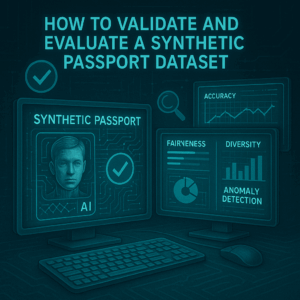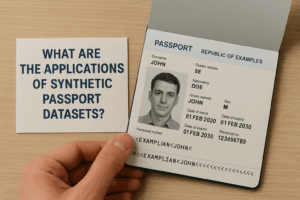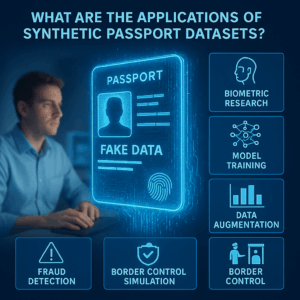A synthetic passport dataset is a collection of artificially generated passport images and their associated data. It’s a type of synthetic data created by computer algorithms to mimic the appearance, structure, and statistical properties of real passports. Unlike real datasets, which contain sensitive personal information (PII), a synthetic passport dataset is entirely fabricated, making it a powerful and safe tool for training and testing machine learning (ML) and artificial intelligence (AI) models. These datasets are essential for developing systems related to identity verification, document analysis, and fraud detection.

Why Are Synthetic Datasets Necessary for AI?
The rapid growth of AI has created a massive demand for high-quality, large-scale datasets. However, real-world data, especially sensitive information like passports, is often difficult and costly to acquire and poses significant privacy risks. Synthetic data addresses these challenges by providing a secure, scalable, and customizable alternative.
Here are the key benefits of using synthetic passport datasets:
- Privacy and Compliance: The most critical advantage is the ability to train AI models without using real people’s data. This eliminates the legal and ethical burdens associated with handling PII, ensuring compliance with strict privacy regulations like the GDPR and CCPA.
- Data Scarcity and Cost-Effectiveness: It’s practically impossible to collect a diverse, worldwide dataset of real passports, particularly for rare nationalities or specific types of fraud. Synthetic data generators can create millions of high-quality, unique passport images on demand, at a fraction of the cost and time of real-world data collection.
- Bias Reduction: Real-world datasets often contain biases that can lead to unfair or inaccurate model performance. For example, a dataset might overrepresent certain demographics while underrepresenting others. Synthetic data allows developers to control the distribution of features, ensuring a balanced and fair dataset that helps to mitigate these biases.
- Creating Edge Cases: In fraud detection, the most valuable data points are the rarest ones—the “edge cases” or subtle forgery attempts. Since these are uncommon in real-world data, synthetic data can be specifically generated to simulate these scenarios, making the ML model more robust and effective at catching sophisticated fraud.
The Technology Behind Synthetic Passport Datasets
Creating a synthetic passport dataset is not a simple task. It requires sophisticated generative AI models to ensure the data is realistic enough to be useful for training. The most common and effective method is using Generative Adversarial Networks (GANs).
How GANs Work to Create Synthetic Data
A GAN consists of two competing neural networks:
- The Generator: This network’s job is to create new, synthetic data (in this case, passport images). It starts with random noise and learns to produce images that are increasingly similar to real passports.
- The Discriminator: This network acts as a “critic.” It’s fed both real passport images and the synthetic images from the generator. Its job is to determine which images are real and which are fake.
This process is a continuous feedback loop. The discriminator provides feedback to the generator, which uses that information to improve its ability to create more realistic fakes. Over many training cycles, the generator becomes so skilled that the discriminator can no longer tell the difference between the real and synthetic data. At this point, the generator can be used to produce an endless supply of high-quality synthetic passports.
Other techniques, such as Variational Autoencoders (VAEs) and hybrid methods that combine generative models with rule-based systems, are also used to create these datasets. These methods can ensure that the synthetic data not only looks real but also adheres to the structural and data requirements of international standards like ICAO Document 9303.
Related Concepts
The field of synthetic data is interconnected with various other topics in AI and technology. Here are some concepts related to synthetic passport datasets:
- Synthetic Data Generation: The overarching process of creating artificial data.
- Generative AI: A class of AI models (including GANs and VAEs) that can generate new content.
- Identity Verification (IDV): The process of verifying a person’s identity, a key application for synthetic passport datasets.
- Machine Learning (ML) Training: The process of using data to train an algorithm to perform a specific task.
- Computer Vision: The field of AI that enables computers to “see” and interpret digital images and videos.
- Document Analysis: The automated process of extracting and understanding information from documents.
- Biometrics: The use of unique physical or behavioral traits (like a passport photo) for identity verification.
- Data Augmentation: A related technique where existing data is modified (e.g., rotated, zoomed, or brightened) to increase the size of a dataset.
Real-World Applications
Synthetic passport datasets are not just a theoretical concept; they are already being used to solve complex, real-world problems.
Table: Synthetic Data Use Cases
| Industry/Field | Application of Synthetic Passport Datasets | Benefits |
|---|---|---|
| Financial Services | Training fraud detection systems to identify fake IDs and documents during account opening. | Reduces financial losses from fraud and enhances security for online banking. |
| Travel & Hospitality | Developing automated check-in kiosks and border control systems that can verify passports instantly. | Speeds up the verification process, reduces human error, and improves security. |
| Government & Security | Training AI to detect sophisticated forgeries and presentation attacks (e.g., fake documents on a screen). | Strengthens national security and helps combat organized crime and human trafficking. |
| Consumer Electronics | Creating robust facial recognition and biometrics systems for unlocking devices and authenticating payments. | Improves the accuracy and security of biometric authentication while protecting user privacy. |
Future Outlook and Challenges
The use of synthetic data is expected to grow exponentially. Gartner predicts that by 2030, synthetic data will completely overshadow real data in AI model development. This shift will make AI development faster, cheaper, and more ethical.
However, challenges remain. A key concern is ensuring that the synthetic data is of high enough quality to be truly representative of the real world. If the synthetic data is not accurate or realistic, it can lead to models that perform well in a test environment but fail in real-world scenarios. Another challenge is the risk of “mode collapse” in GANs, where the generator produces a limited range of outputs, reducing the diversity of the synthetic dataset.
Researchers and developers are constantly working to improve generative models and create more sophisticated synthetic data generation pipelines to overcome these limitations. As these technologies mature, synthetic passport datasets will become an indispensable tool in the global effort to secure identities and combat fraud.
FAQs
It’s a collection of artificially generated passport images used for training and testing ML models.
They allow researchers to improve ID verification models without using sensitive real-world passport data.
It may contain thousands of AI-generated passport photos, document layouts, and text variations.
Yes, since they don’t contain real personal information, they are safe for research and development.
AI researchers, security companies, and fintech firms use them to train fraud detection systems.


